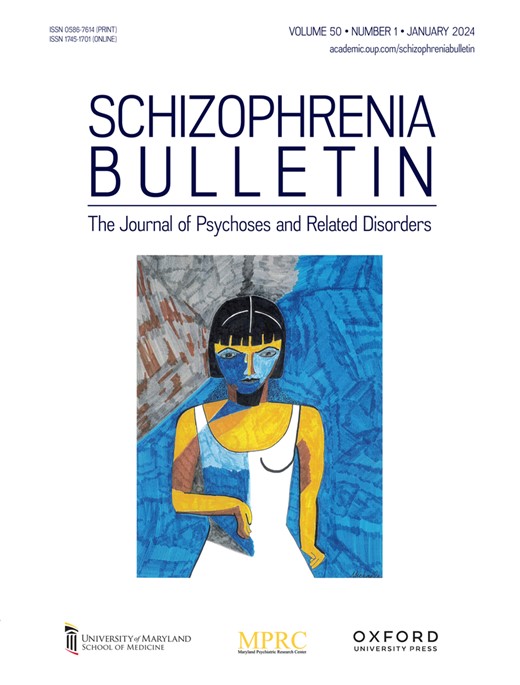综合风险:青少年的多环境风险评分和精神病症状
IF 4.8
1区 医学
Q1 PSYCHIATRY
引用次数: 0
摘要
背景与假设精神病症状在青少年中很常见,是精神障碍的前兆。许多危险因素已被证明先于精神疾病。然而,调查单个风险因素并不能解释这些风险因素可能产生的累积效应。因此,我们将研究充分的精神障碍环境风险因素结合在一个复合测量中:多环境风险评分(PERS)。研究设计对801名有精神病理风险的青少年(15岁)进行风险因素评估。二元危险因素包括冬季出生、低胎龄、低出生体重、少数民族、城市生活环境、大麻使用、欺凌受害者、情感虐待、身体虐待、性虐待、父亲年龄高、父母严重精神疾病、父母离婚和父母死亡。PERS是用最近的荟萃分析得出的对数赔率加权的。在18岁时,评估自我报告的精神病经历(PE)和临床评定的精神病症状(PS)。更新后的PERS与之前的PERS模型进行了比较,后者包括更少的风险因素和不同的权重。研究结果:PERS与PE和PS有关。具体来说,PERS在3 - 4之间,而PERS &;gt;4个孩子在青春期后期出现精神病症状的几率分别增加2.2倍和5.2倍。更新后的14项PERS与以前的PERS相比表现更好。结论:15岁时测量的儿童和青少年危险因素综合评分与18岁时的精神病症状相关。未来的研究应该在检查精神病理的决定因素时考虑风险因素的累积效应。本文章由计算机程序翻译,如有差异,请以英文原文为准。
Combining the Risk: The Poly-Environmental Risk Score and Psychotic Symptoms in Adolescents
Background and Hypothesis Psychotic symptoms are common in adolescents and predictive of psychiatric disorders. Numerous risk factors have been shown to precede psychiatric disorders. However, investigating individual risk factors does not account for the cumulative effect these risk factors may have. Therefore, we combined well-researched environmental risk factors for psychotic disorder in a composite measure: the poly-environmental risk score (PERS). Study Design Risk factors were assessed in a cohort of 801 adolescents (aged 15) at risk for psychopathology. Binarized risk factors included winter birth, low gestational age, low birth weight, ethnic minority status, urban living environment, cannabis use, victim of bullying, emotional abuse, physical abuse, sexual abuse, high paternal age, parental severe mental illness, parental divorce, and parental death. The PERS was weighted with the log odds derived from recent meta-analyses. At age 18, self-reported psychotic experiences (PE) and clinician-rated psychotic symptoms (PS) were assessed. This updated PERS was compared to previous PERS models, which included fewer risk factors and different weightings. Study Results The PERS was associated with PE and PS. Specifically, a PERS between 3 and 4, and PERS > 4 corresponded with a 2.2- and 5.2-fold increase in the odds of psychotic symptoms in late adolescence. The updated 14-item PERS performed better compared to previous compositions of the PERS. Conclusions A composite score of childhood and adolescent risk factors measured at age 15 was associated with psychotic symptoms at age 18. Future research should consider the cumulative effect of risk factors when examining the determinants of psychopathology.
求助全文
通过发布文献求助,成功后即可免费获取论文全文。
去求助
来源期刊

Schizophrenia Bulletin
医学-精神病学
CiteScore
11.40
自引率
6.10%
发文量
163
审稿时长
4-8 weeks
期刊介绍:
Schizophrenia Bulletin seeks to review recent developments and empirically based hypotheses regarding the etiology and treatment of schizophrenia. We view the field as broad and deep, and will publish new knowledge ranging from the molecular basis to social and cultural factors. We will give new emphasis to translational reports which simultaneously highlight basic neurobiological mechanisms and clinical manifestations. Some of the Bulletin content is invited as special features or manuscripts organized as a theme by special guest editors. Most pages of the Bulletin are devoted to unsolicited manuscripts of high quality that report original data or where we can provide a special venue for a major study or workshop report. Supplement issues are sometimes provided for manuscripts reporting from a recent conference.
 求助内容:
求助内容: 应助结果提醒方式:
应助结果提醒方式:


